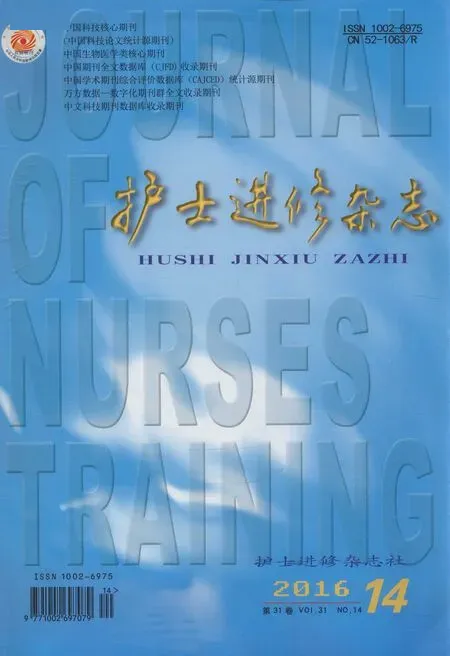口腔運動干預對早產兒出院后母乳喂養的影響
李琳琳 陳京立 崔國鳳
(1.北京協和醫學院護理學院,北京 100144;2.中國醫學科學院北京協和醫學院北京協和醫院兒科,北京 100144)
?
口腔運動干預對早產兒出院后母乳喂養的影響
李琳琳1陳京立1崔國鳳2
(1.北京協和醫學院護理學院,北京 100144;2.中國醫學科學院北京協和醫學院北京協和醫院兒科,北京 100144)
目的 探討口腔運動干預對早產兒出院后母乳喂養的影響。方法 便利抽樣60例早產兒,按時間順序分為對照組和觀察組,各30例。兩組接受相同的常規早產兒治療和護理。觀察組每天1次喂養前給予5 min的口腔運動干預,對照組30例僅予非營養性吸吮。觀察隨訪兩組出院1個月、3個月時母乳喂養率、親喂率及瓶喂原因。結果 兩組早產兒出院1個月、3個月時母乳喂養率、親喂率及出院3個月時乳頭混淆的發生率差異有統計學意義(P<0.05),而出院1個月時兩組乳頭混淆的發生率差異無統計學意義(P>0.05)。結論 口腔運動干預對早產兒出院后的母乳喂養有積極意義。
口腔運動干預; 早產兒; 母乳喂養
《早產/低出生體重兒喂養建議》[1]指出,早產兒出院后的乳類選擇應以母乳或強化母乳為首選。然而很多早產兒出院時吸吮功能尚未成熟。調查[2]顯示:30.5%的極低出生體重兒在出院后接受母乳喂養,僅有10%可直接由母親親喂。口腔運動干預是指在早產兒開始經口喂養前或經口喂養過渡階段,采取口腔內外按摩刺激、非營養性吸吮結合喂養時下頜支持等方法,對口咽部組織或肌肉群進行感官刺激[3]。國內外已有一些研究[4-9]證實,口腔運動干預可增強早產兒的吸吮力,改善早產兒奶瓶喂養表現,加速喂養進程,改善喂養結局。但尚沒有研究驗證口腔運動干預對早產兒出院后母乳喂養有何影響。我科從2014年開始,對出生胎齡小于34周的早產兒給予口腔運動干預,并對他們出院后的母乳喂養情況進行電話隨訪,現將研究結果報告如下。
1 對象與方法
1.1 研究對象 選擇2014年1月-2015年6月我院新生兒重癥監護室(Neonatal intensive care unit,NICU)收治的出生胎齡為25~34周的早產兒60例,取前30例為對照組,后30例為觀察組。納入標準:出生胎齡25~34周;住院期間純母乳喂養或混合喂養(指部分母乳、部分配方奶喂養);知情同意。排除標準:患有影響母乳喂養的先天性畸形;嚴重胃腸道、心血管、神經系統、遺傳代謝性疾病;因母親因素無法哺乳(如母親疾病、用藥需停止哺乳,母親乳房疾病無法喂母乳);因治療需要特殊配方奶喂養。
1.2 方法
1.2.1 干預方法 (1)觀察組:接受常規早產兒治療和護理,同時每天1次喂養前給予5 min的口腔運動干預,即口腔按摩刺激加非營養性吸吮(Non-nutritive sucking,NNS)。干預方法來自Lessen[10]創建的早產兒口腔運動干預法(Preterm infant oral motor intervention,PIOMI)的視頻;干預時間從撤除有創機械通氣24 h后開始(最早不超過29周),至可完全經口喂養48 h為止,具體方法,見表1。(2)對照組:接受與觀察組患兒相同的常規早產兒治療和護理,患兒哭鬧、管飼喂養時及經口喂養前給予NNS。

表1 早產兒口腔運動干預方法
1.2.2 觀察指標與收集方法 (1) 一般資料:采用自行設計的調查表收集早產兒及其母親的人口學統計和臨床資料,包括早產兒的性別、出生胎齡、出生及出院體質量、入院及出院診斷、住院天數、管飼喂養天數,早產兒母親的年齡、分娩方式、孕次、產次、既往史、圍產期病史及藥物使用情況。(2)健康狀況:1 min、5 min Apgar評分評價。 (3)母乳喂養情況:包括住院期間母乳喂養率(含母乳喂養和強化母乳喂養),出院后1個月和3個月的母乳喂養率、親喂率(吸吮母親乳房喂養次數/總喂養次數(吸吮乳房喂養與奶瓶喂養次數之和)×100%、瓶喂率(奶瓶喂養次數/總喂養次數(吸吮乳房喂養與奶瓶喂養次數之和)×100%、無法親喂原因。
1.2.3 統計學方法 采用SPSS 20.0統計分析軟件進行數據錄入、處理與分析。計量資料如為正態分布,用(均數±標準差)描述,兩組間比較用t檢驗;如為非正態分布,用中位數和四分位數間距描述,兩組間比較分析用非參數檢驗中的Mann-Whitney秩和檢驗。 計數資料用卡方檢驗,P<0.05為差異有統計學意義。
2 結果
2.1 兩組患兒一般資料比較 見表2。

表2 兩組患兒一般資料比較 例(%)

續表2 兩組患兒一般資料比較 例(%)
2.2 兩組患兒出院1個月時喂養方式比較 見表3。

表3 兩組患兒出院1個月時喂養方式比較 例(%)
2.3 兩組患兒出院3個月時喂養方式比較 見表4。

表4 兩組患兒出院3個月時喂養方式比較 例(%)
3 討論
3.1 口腔運動干預的作用原理 口腔運動干預可以降低口部肌肉的敏感性,增加口周肌肉運動范圍和強度,增強口腔運動組織能力,促進反射行為,提高吸吮次數,改善吸吮行為,以實現營養性吸吮[4,10]。Rocha等[6]的研究認為,口腔感覺運動刺激能促進神經結構的成熟,改善吸吮-吞咽-呼吸三者間的協調性。哺乳動物的吸吮活動受中央模式發生器(Central pattern generator,CPG)調控[11],CPG可以根據傳入神經沖動對吸吮模式產生調控效應,以適應不斷變化的進食狀態,即感覺刺激傳遞到嬰兒的口腔感覺器官,能夠激發CPG。這為口腔運動功能發育成熟前開始經口喂養并開展口腔運動干預提供了理論支持。表4提示,吸吮能力的提高,對早產兒直接吸吮母親乳房也有正面的影響。
3.2 早產兒出院后喂養方式的分析 母乳喂養不僅可以減少早產兒在NICU住院期間不成熟視網膜(Retinopathy of prematurity,ROP)[12]、感染性疾病[13]、壞死性小腸結腸炎[14]等疾病的發病率,也能影響他們的遠期生長發育[15-16]。一項對1 034例超低出生體重兒的多中心研究[17]顯示,母乳喂養與兒童18個月和30個月時神經認知發育相關,并降低了早產兒生后1年的再入院率。由表2、3可知,本研究觀察組早產兒從NICU出院后1個月、3個月時純母乳喂養率、全親喂的百分比都顯著高于對照組,全瓶喂的百分比顯著低于對照組(P<0.05),證明口腔運動干預可促進早產兒出院后的母乳喂養率及親喂率。研究結果表明,對于經口喂養困難的早產兒,應當在其健康狀況相對穩定的時候及時給予口腔運動干預,這不僅能加強早產兒的吸吮力,使他們通過親喂得到更多的母乳,也可能對其母親母乳產量產生積極作用,但口腔運動干預對母親產乳量的影響尚有待進一步研究。
3.3 早產兒出院后不能親喂的原因分析 乳頭混淆是指嬰兒因為吸吮母親乳頭之前吸吮了人工乳頭(奶瓶),或者頻繁使用奶瓶,而不會吸吮或不愿吸吮母乳的現象,是影響母乳喂養的一個重要因素,吸吮母乳和吸吮奶瓶的動作和技術不同,嬰兒習慣了奶瓶的吸吮方式之后,在吸吮母乳時就產生了技術上的混淆。對于NICU的早產兒來說,因治療需要,奶瓶喂養不可避免。極(超)低出生體重兒或有宮外生長發育遲緩等問題的早產兒,出院后仍需繼續以強化母乳作為其主要營養來源。本研究結果顯示:出院1個月時兩組分別有20.0%和13.3%的早產兒因需繼續強化而不得不全部或部分依靠奶瓶喂養。奶瓶喂養會增加嬰兒乳頭混淆的風險。本研究結果證明,觀察組早產兒出院后3個月時因乳頭混淆而無法親喂的百分比顯著低于對照組。提示我們對于出生體重低、有宮外生長發育遲緩的早產兒,應給予口腔運動干預直至出院。出院后可指導家長繼續進行有針對性地口腔運動干預,并觀察這種方法是否能改善早產兒長期瓶喂造成的乳頭混淆。
綜上所述, 口腔運動干預可提高早產兒出院后的親喂率及母乳喂養率,但對乳頭混淆及通過吸吮使母親奶量改變的影響仍有待進一步研究。本研究對象僅選擇了北京市一家綜合性醫院NICU,樣本代表性方面有一定局限性,在一定程度上局限了研究成果的推廣。建議未來進行多中心、大樣本量的研究,為早產兒提供個體化的喂養方案,以促進早產兒的生長發育。
[1] 《中華兒科雜志》編輯委員會,中華醫學會兒科學分會新生兒學組,中華醫學會兒科學分會兒童保健學組.早產/低出生體質量兒喂養建議[J].中華兒科雜志,2009,47(7):508-510.
[2] Meier PP,Engstrom JL.Preventing,diagnosing and managing slow weight gain in the human milk-fed very low birthweight infant[C].Sulla Nutrizione Con Latte Materno,2008:33-47.
[3] 李琳琳,張勝男,孫靜.早產兒口腔運動干預方法研究進展[J].護理學報,2014,21(6):38-41.
[4] Fucile S,Gisel E,Lau C.Oral stimulation accelerates the transition from tube to oral feeding in preterm infants[J].J Pediatrics,2002,141(2): 230-236.
[5] Lessen BS.Effect of the premature infant oral motor intervention on feeding progression and length of stay in preterm infants[J].Advances in Neonatal Care,2011,11(2): 129-139.
[6] Rocha AD,Moreira ME,Pimenta HP,et al.A randomized study of the efficacy of sensory-motor-oral stimulation and non-nutritive sucking in very low birthweight infant[J].Early Human Devlopment,2007,83(6):385-388.
[7] Borion M,Da Nobrega L,Roux S,et al.Effect of oral stimulation and oral support on non-nutritive sucking and feeding performance in preterm infants[J].Dev Med Child Neurol,2007,49,439-444.
[8] 呂天嬋,張玉俠,胡曉靜,等.早期口腔運動干預方案改善早產兒經口喂養的效果評價[J].中華護理雜志,2013,48(2):101-105.
[9] 陳喻萍,施曉柯,陳丹,等.口腔運動干預對早產兒經口喂養進程的影響[J].廣東醫學,2013,34(4):652-654.
[10] Borion M,Da Nobrega L,Roux S,et al.Effect of oral stimulation and oral support on non-nutritive sucking and feeding performance in preterm infants[J].Dev Med Child Neurol,2007,49(6):439-444.
[11] Barlow SM.Oral and respiratory control for preterm feeding[J].Current Opinon Otolaryngology Head and Neck Surgery,2009,17(3):179-186.
[12] Hylander MA,Strobino DM,Pezzullo JC,et al.Association of human milk feedings with a reduction in retinopathy of prematurity among very low birth weight infants[J].J Perinatol,2001,21(6):356-362.
[13] Patel AL,Johnson TJ,Engstrom JL,et al.Impact of early human milk on sepsis and health-care costs in very low birth weight infants[J].J Perinatol,2013,33(7):514-519.
[14] Sullivan S,Schanler RJ,Kim JH,et al.An exclusively human milk-based diet is associated with a lower rate of necrotizing enterocolitis than a diet of human milk and bovine milk-based products[J].Pediatrics,2010,156(4):562-567.
[15] Vohr BR,Poindexter BB,Dusick AM,et al.NICHD Neonatal Research Network.Beneficial effects of breast milk in the neonatal intensive care unit on the developmental outcome of extremely low birth weight infants at 18 months of age[J].Pediatrics,2006,118(1):115-123.
[16] Lucas A,Morley R,Cole TJ,et al.Breast milk and subsequent intelligence quotient in children born preterm[J].Lancet,1992,339(8788):261-264.
[17] Vohr BR,Poindexter BB,Dusick AM,et al.Beneficial effects of breast milk in the neonatal intensive care unit on the developmental outcome of extremely low birth weight infants at 18 months of age[J].Pediatrics,2006,118(1):115-123.
Effect of oral motor intervention on breast feeding for preterm infants discharged from hospital
Li Linlin1, Chen Jingli1, Cui Guofeng2
(1.CollegeofNursing,PekingUnionMedicalCollege,Beijing100144;2.Pediatrics,ChinaAcademyofMedicalSciences,PekingUnionMedicalCollege,Beijing100144)
Objective To investigate the effect of oral motor intervention on breast feeding for preterm infants discharged from hospital.Methods 60 cases of preterm infants recruited by convenient sampling were divided into two groups by temporal sequence.30 cases in each group,The two groups received the same routine care.The infants in experimental group received 5min’s oral motor intervention once a day before feeding,while the other infants received non-nutritional sucking only.The rate of breast feeding and parent feeding rate,the reasons for bottle-feeding of the preterm infants were observed after discharged for the first month and third month.Results There were statistically significant differences in the rate of breast feeding and parent feeding rate after discharged for first month and third month,and the rate of nipple confusion in the third month after they discharged(P<0.05).However,there was no significant difference between the two groups in rate of nipple confusion in the first month(P>0.05).Conclusion Oral motor intervention had positive significance in human milk feeding for preterm infants after discharge from hospital.
Oral motor intervention; Premature infant; Breast feeding
李琳琳(1982-),女,遼寧,研究生在讀,主管護師,研究方向:兒科護理
陳京立,E-mail:jingli204@sina.com
R473.72,R473.78
A
10.16821/j.cnki.hsjx.2016.14.006
2015-12-29)

